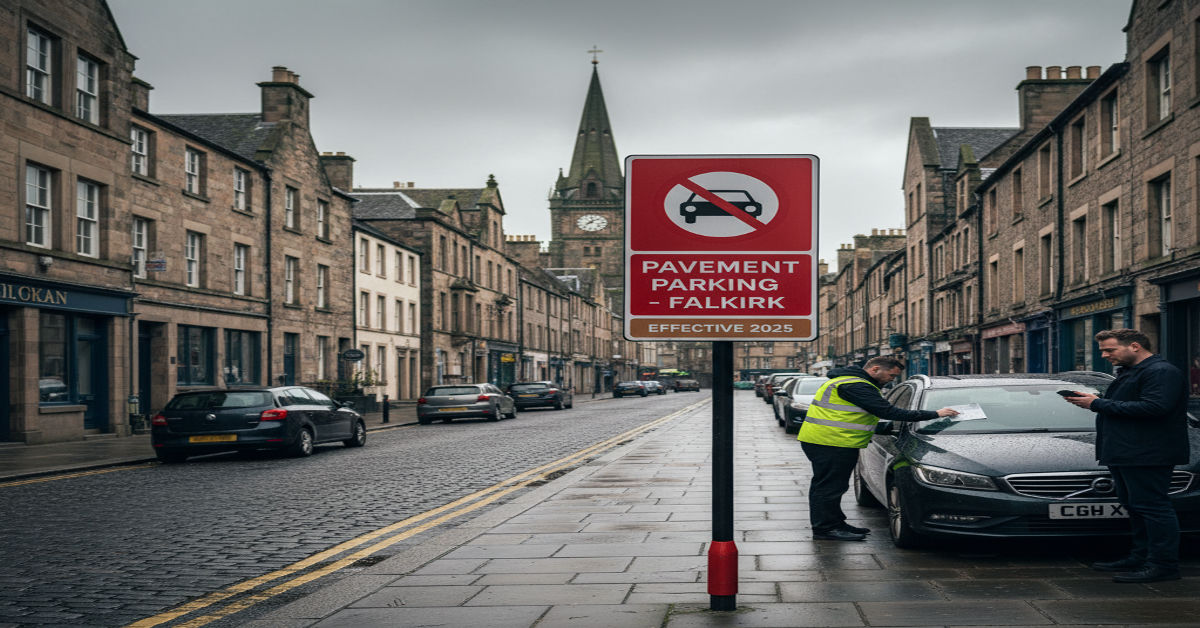Falkirk’s pavement parking ban marks one of the most significant local transport policy changes of the decade. Starting in August 2025, the town’s roads will enter a new era where motorists are held accountable for how their vehicles affect pedestrian safety and accessibility. For years, the sight of cars edging halfway across pavements was accepted as normal, but this habit came with costs—cracked walkways, obstructed wheelchairs, and danger for children and visually impaired pedestrians. The new rules aim to create safer, more respectful streets that serve all members of the community equally.
This move forms part of a nationwide shift driven by Scotland’s commitment to inclusive urban design and environmental responsibility. The Falkirk pavement parking ban doesn’t just enforce penalties; it reshapes how people view shared public space. Through better regulation, improved awareness, and strict enforcement, Falkirk hopes to set an example for other regions balancing the needs of motorists and pedestrians.
Background: The Evolution of Pavement Parking Laws in Scotland
Pavement parking is not a new concern in Scotland. It has been debated for decades in Parliament and among local councils due to growing conflicts between drivers and pedestrians. The problem intensified with rising car ownership and denser urban development. Vehicles frequently occupied pavements to make way for passing traffic, unintentionally endangering those walking. Following public consultation and advocacy from accessibility groups, the Transport (Scotland) Act 2019 gave councils the power to prohibit footway and double parking across the country.
This act was not enforced immediately; local authorities needed time to prepare, assess roads, and communicate with the public. By 2023, Transport Scotland issued national guidance to ensure consistent enforcement across local areas. Falkirk Council began preparing soon after, reviewing thousands of streets to determine where exemptions might apply. This gradual rollout ensured that the law would be implemented fairly, allowing residents to adjust while prioritizing vulnerable pedestrians.
| Timeline of Policy Development | Key Milestone | Description |
| 2019 | Transport (Scotland) Act passed | Established national power to ban pavement parking |
| 2023 | Guidance published | Transport Scotland issued national enforcement framework |
| 2024 | Public advisory notices | Falkirk Council began awareness campaigns |
| 2025 | Enforcement begins | Fines and full implementation start August 18, 2025 |
Why Falkirk Needed a Pavement Parking Ban
Falkirk’s streets are a blend of narrow historic lanes and modern estates, many designed long before cars became so common. The increase in residential parking demand led many motorists to mount pavements to leave room for other vehicles. However, what seemed practical to drivers became a hazard to pedestrians. According to The Scottish Government, nearly one in three pedestrians in urban areas reported difficulty navigating pavements due to parked cars. These obstacles were particularly dangerous for wheelchair users and parents pushing prams.
Implementing the Falkirk pavement parking ban is a direct response to this long-standing accessibility issue. The goal is not merely to penalize but to foster civic responsibility and awareness. The ban ensures pavements are kept clear for their intended users—people on foot. It also prevents infrastructure damage caused by heavy vehicles cracking slabs or compacting soil beneath verges. Over time, this regulation could improve both safety and the visual appeal of Falkirk’s urban environment.
The Legal Foundation and How It Works
The ban operates under powers granted by the Transport (Scotland) Act 2019, which specifically prohibits parking on pavements, double parking, and blocking dropped kerbs. This legal foundation aligns with broader UK-wide accessibility goals set by agencies like GOV.UK’s Department for Transport, ensuring consistency between national and local enforcement. Falkirk Council, as a permitted parking authority, now manages both the administrative and operational sides of the new law.
For clarity, the legal definition of “pavement” covers any footway or verge adjacent to the carriageway. Enforcement officers will use photographic evidence to identify violations, issue fines, and maintain transparency in the appeal process. The structure ensures accountability for drivers while maintaining fairness through clear signage and exemptions. The emphasis is not solely punitive; it’s about educating the public to change ingrained parking habits that compromise pedestrian safety.
| Legal Aspect | Definition | Responsible Body |
| Pavement Parking | Stopping with any part of the vehicle on the footway or verge | Falkirk Council |
| Dropped Kerb Blocking | Preventing access for wheelchairs, prams, or driveways | Local enforcement officers |
| Double Parking | Parking alongside another parked vehicle | Parking enforcement teams |
| Fine Amount | £100 (£50 if paid within 14 days) | Council administration under national law |
When the Ban Starts and What It Means for Drivers
Enforcement of the Falkirk pavement parking ban officially begins on 18 August 2025. Before that, from May 2024, the council ran a transition phase using advisory notices to prepare residents. These notices acted as warnings rather than fines, giving drivers time to understand and adapt to the upcoming rules. This educational approach aligns with best practices recommended by Transport Scotland, emphasizing guidance before penalties.
From the enforcement date, any driver found parking on pavements, verges, or blocking dropped kerbs will receive a Penalty Charge Notice (PCN) of £100, reduced to £50 if paid within two weeks. Repeat offenders may also face additional enforcement measures. The aim is deterrence, not punishment, encouraging drivers to respect shared space. For everyday motorists, this means becoming more strategic about where to park—using driveways, off-street car parks, or designated parking areas rather than relying on roadside pavements.
Key Offences Covered Under the Falkirk Rules
The Falkirk pavement parking ban addresses multiple forms of obstruction that compromise accessibility and road safety. Firstly, parking with even one wheel on a pavement is an offence unless explicitly exempted. Secondly, double parking—where a vehicle stops alongside another parked car, reducing road width—is strictly prohibited. Thirdly, blocking dropped kerbs, whether leading to homes, crossings, or access points, is considered an obstruction of public right-of-way.
Although these may seem straightforward, confusion often arises regarding temporary stops. For instance, short stops for passenger drop-offs may be allowed if the vehicle remains attended and does not obstruct movement. Similarly, loading and unloading may be permitted for brief periods if no other practical alternative exists. However, in every case, at least 1.5 metres of pavement must remain unobstructed for pedestrian passage. This standard mirrors the accessibility guidance set by Transport Scotland, promoting uniform pedestrian safety nationwide.
Who Is Exempt and Why
While the rules are firm, they recognize situations where flexibility is necessary. Exemptions apply to emergency services such as police, ambulance, and fire vehicles when responding to incidents. Utility and maintenance vehicles may also be permitted temporary access if essential work is being carried out. Additionally, specific exemptions can be applied to certain narrow streets where pavement parking is unavoidable without obstructing traffic flow. Falkirk Council identified 21 such streets, which are still under review for final exemption status.
Another category of exemption involves short-term loading or unloading activities where no feasible alternative exists. In such cases, vehicles may stop briefly on pavements provided pedestrian safety isn’t compromised. Drivers involved in construction, deliveries, or removals can apply for temporary permissions through the council’s road occupation permit system. These allowances demonstrate a balance between practicality and protection, ensuring enforcement remains fair rather than excessive.
| Exemption Type | Eligibility | Duration | Conditions |
| Emergency Vehicles | Police, Ambulance, Fire | As required | Must be in active service |
| Utility Maintenance | Gas, water, telecom repair | Temporary | Must display authorization |
| Loading/Unloading | Delivery vans | Up to 20 minutes | Must leave 1.5m clear path |
| Approved Exempt Streets | 21 under review | Permanent (if approved) | Council signage required |
How Falkirk Council Prepared for Enforcement
Falkirk Council took a proactive, community-focused approach to preparing for enforcement. Over 2,300 streets were assessed to identify which would be most affected and where exemptions might apply. The council distributed thousands of leaflets, posted FAQs online, and issued 1,800 advisory notices as part of its public education campaign. Officers engaged directly with local businesses and residents to explain the reasoning behind the ban and gather feedback before the official rollout.
In addition to outreach, the council improved its enforcement infrastructure by training wardens, updating signage, and integrating its online reporting system with photographic verification. These steps aim to make the enforcement process transparent and efficient. According to best practice recommendations from The Scottish Government, consistency and clarity are key to achieving long-term behavioral change. By prioritizing public understanding over immediate punishment, Falkirk ensures compliance becomes a shared community goal.
Reporting and Challenging Parking Fines
When enforcement begins, drivers who receive a Penalty Charge Notice will have clear channels for both payment and appeal. The fine can be paid online within 14 days for a discounted rate or challenged through the council’s formal dispute process. Appeals are reviewed individually, considering evidence such as unclear signage, medical emergencies, or procedural errors. The appeal process mirrors national parking standards set by the Department for Transport, ensuring fairness and accountability.
Residents may also report violations through the council’s online portal. Photos and precise location details help enforcement officers verify and act swiftly. This participatory system not only strengthens compliance but also builds trust between residents and authorities. While some drivers may find this transition challenging, transparency and communication ensure that genuine mistakes are treated with understanding while persistent offenders face firm penalties.
Social and Economic Impact on Residents and Businesses
The new rules bring broad implications beyond traffic management. For residents, they mean adapting to new parking behaviors—particularly in neighborhoods where on-street space is scarce. Yet, the benefits are substantial. Safer pavements enhance walkability, encourage active travel, and improve quality of life for vulnerable pedestrians. Over time, this contributes to healthier communities and potentially boosts local commerce as pedestrian-friendly streets attract more visitors.
Businesses, especially those relying on deliveries, will need to adjust operational habits. Scheduling deliveries during off-peak hours or using dedicated loading bays will minimize disruptions. Local authorities are also exploring ways to increase short-stay parking near commercial zones to support small businesses. According to research from BBC News, towns that invest in pedestrian-first infrastructure often experience higher footfall and greater retail vitality. Thus, while change may initially cause inconvenience, the long-term gains outweigh short-term adjustments.
| Stakeholder Group | Short-Term Impact | Long-Term Benefit |
| Residents | Must find alternative parking | Safer, more walkable neighborhoods |
| Businesses | Adjust delivery logistics | Increased pedestrian traffic and accessibility |
| Pedestrians | Immediate improvement in safety | Consistent, unobstructed routes |
| Local Council | Enforcement challenges | Enhanced civic reputation and compliance |
How Falkirk Compares to Other Scottish Councils
Falkirk is not alone in implementing a pavement parking ban. Edinburgh was the first Scottish city to enforce it in early 2024, followed by Aberdeen and Glasgow later that year. However, Falkirk’s phased approach and extended advisory period set it apart. This strategy reflects lessons learned from larger cities, focusing on gradual education and community cooperation. According to The Guardian, cities that introduce new regulations with adequate adjustment periods achieve higher long-term compliance rates.
While all councils adhere to the same national framework, local variations exist. Falkirk’s balanced approach between enforcement and exemption ensures fairness for areas with limited space while maintaining pedestrian rights. This model could serve as a template for smaller councils across Scotland, showing that local nuance and public engagement are vital for successful implementation.
Smart Tips to Avoid Fines and Stay Compliant
Adapting to the new rules is straightforward with awareness and planning. Always ensure your vehicle is parked fully on the road and never on the pavement edge. Use official parking bays or off-street car parks, which are widely available across Falkirk. If you’re unsure whether an area is exempt, look for council signage or consult the latest updates on the official council website. Planning ahead reduces stress and prevents costly mistakes.
Drivers making deliveries or quick stops should always leave at least 1.5 metres of pedestrian space and keep stops under 20 minutes when possible. For visitors, park-and-ride facilities offer convenient alternatives close to key town destinations. Above all, consider the perspective of pedestrians—especially those who rely on clear pavements for safety. Responsible parking supports the broader goal of creating a community that respects accessibility and mobility for everyone.
Conclusion and Call to Action
The Falkirk pavement parking ban is more than a new traffic rule—it’s a statement about shared respect for public space. By enforcing this policy, the council not only protects pedestrians but also modernizes how communities think about accessibility and fairness. While adaptation may take time, the long-term outcome will be a cleaner, safer, and more organized urban environment that benefits everyone.
Drivers are encouraged to familiarize themselves with the new law, plan their parking responsibly, and participate in building safer streets. For official updates or specific exemption information, visit Transport Scotland or The Scottish Government’s official website. Stay informed, stay compliant, and help Falkirk move toward a more inclusive future for all road users.







